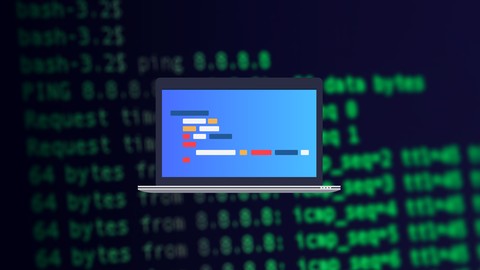
Bash Shell Scripting Tutorial for Beginners
Bash Shell Scripting Tutorial for Beginners, available at $64.99, has an average rating of 4.55, with 87 lectures, based on 865 reviews, and has 9107 subscribers.
You will learn about By the end of it you will be familiar with most of the common tasks we normally do on Bash scripting You will be comfortable, efficient, and effective at the shell scripting Automate the frequently performed tasks. This course is ideal for individuals who are This course is designed for beginners, especially users who have never written bash script before or People thinking about a career as a Linux system administrator or engineer, but need the basics first. It is particularly useful for This course is designed for beginners, especially users who have never written bash script before or People thinking about a career as a Linux system administrator or engineer, but need the basics first.
Enroll now: Bash Shell Scripting Tutorial for Beginners
Summary
Title: Bash Shell Scripting Tutorial for Beginners
Price: $64.99
Average Rating: 4.55
Number of Lectures: 87
Number of Published Lectures: 87
Number of Curriculum Items: 87
Number of Published Curriculum Objects: 87
Original Price: $89.99
Quality Status: approved
Status: Live
What You Will Learn
- By the end of it you will be familiar with most of the common tasks we normally do on Bash scripting
- You will be comfortable, efficient, and effective at the shell scripting
- Automate the frequently performed tasks.
Who Should Attend
- This course is designed for beginners, especially users who have never written bash script before
- People thinking about a career as a Linux system administrator or engineer, but need the basics first.
Target Audiences
- This course is designed for beginners, especially users who have never written bash script before
- People thinking about a career as a Linux system administrator or engineer, but need the basics first.
Linux has a variety of different shells Like Bourne shell (sh), C shell (csh), Korn shell (ksh), TC shell (tcsh), Bourne Again shell (bash). Certainly the most popular shell is “bash”. Bash is an sh-compatible shell that incorporates useful features from the Korn shell (ksh) and C shell (csh). bashis not only an excellent command line shell, but a scripting language in itself. Shell scripting allows us to use the shell’s abilities and to automate a lot of tasks that would otherwise require a lot of commands.
Bash scripting will help you automate routine tasks and save valuable time, whether you’re a sys admin, Linux user or software developer. Shell script is much quicker than programming in any other languages.
The goal of this course is to provide you with a working knowledge of Bash scripting. We’ll start with the basics, starting from creating our first Bash scriptand running it. Next you will learn about the bash environment, local variables, conditional statements, functions, loops, case statements, string operations, and coprocesses.
Course Curriculum
Chapter 1: Linux Command Line Tutorial
Lecture 1: Introduction
Lecture 2: ls command in Linux
Lecture 3: cd command in Linux
Lecture 4: cat command in Linux
Lecture 5: I/O Redirection
Lecture 6: mkdir Command
Lecture 7: rm and rmdir commands for linux
Lecture 8: cp command
Lecture 9: mv command
Lecture 10: less command
Lecture 11: touch command
Lecture 12: nano command
Lecture 13: sudo command
Lecture 14: top command
Lecture 15: kill command
Lecture 16: echo command
Lecture 17: file permissions, symbolic permissions and chmod
Lecture 18: directory permissions and chmod
Lecture 19: Octal and Numerical permissions (chmod)
Lecture 20: Introduction to Bash Scripting
Lecture 21: which and whatis command
Lecture 22: useradd command (Creating Users)
Lecture 23: userdel command (Removing Users)
Lecture 24: Basic Group Management (groups, groupadd, groupdel)
Lecture 25: .bashrc File
Lecture 26: Viewing Resources (du , df, free command)
Lecture 27: watch command
Lecture 28: Head and Tail Commands
Lecture 29: find command
Lecture 30: wc command
Lecture 31: cal command
Lecture 32: date command
Lecture 33: How to Run multiple Terminal Commands
Lecture 34: apt-get command to Install Software
Lecture 35: ifconfig command
Lecture 36: tar command to Compress and Extract Files
Lecture 37: grep command
Lecture 38: netstat command
Lecture 39: How to Enable SSH in Ubuntu 16.04 LTS (Install openssh-server)
Lecture 40: How to Install PuTTY on Windows + SSH Connections Using PuTTY on Windows
Lecture 41: scp command – SCP to Securely Transfer Files/Folders in Linux
Chapter 2: Bash Shell Scripting Tutorial
Lecture 1: Bash Introduction
Lecture 2: using Variables and Comments
Lecture 3: using Variables and Comments Example
Lecture 4: Read User Input
Lecture 5: Read User Input Example
Lecture 6: Pass Arguments to a Bash-Script
Lecture 7: Pass Arguments to a Bash-Script Example
Lecture 8: If Statement ( If then , If then else, If elif else)
Lecture 9: If Statement ( If then , If then else, If elif else) Example
Lecture 10: File test operators
Lecture 11: File test operators Example
Lecture 12: How to append output to the end of text file
Lecture 13: How to append output to the end of text file Example
Lecture 14: Logical 'AND' Operator
Lecture 15: Logical 'AND' Operator Example
Lecture 16: Logical 'OR' Operator
Lecture 17: Logical 'OR' Operator Example
Lecture 18: Perform arithmetic operations
Lecture 19: Perform arithmetic operations Example
Lecture 20: Floating point math operations in bash | bc Command
Lecture 21: Floating point math operations in bash | bc Command Example
Lecture 22: The case statement
Lecture 23: The case statement Example 1
Lecture 24: The case statement Example
Lecture 25: The case statement Example 2
Lecture 26: Array variables
Lecture 27: Array variables Example
Lecture 28: WHILE Loops
Lecture 29: WHILE Loops Example
Lecture 30: using sleep and open terminal with WHILE Loops
Lecture 31: using sleep and open terminal with WHILE Loops Example
Lecture 32: Read a file content in Bash
Lecture 33: UNTIL loop
Lecture 34: UNTIL loop Example
Lecture 35: FOR loop
Lecture 36: FOR loop Example
Lecture 37: use FOR loop to execute commands
Lecture 38: FOR loop to execute commands Example
Lecture 39: Select loop
Lecture 40: Break and continue
Lecture 41: Functions
Lecture 42: Local variables
Lecture 43: Function Example
Lecture 44: Readonly command
Lecture 45: Signals and Traps
Lecture 46: How to debug a bash script
Instructors
-
Yogesh Patel
Software Developer and Programming Enthusiast
Rating Distribution
- 1 stars: 11 votes
- 2 stars: 15 votes
- 3 stars: 108 votes
- 4 stars: 359 votes
- 5 stars: 372 votes
Frequently Asked Questions
How long do I have access to the course materials?
You can view and review the lecture materials indefinitely, like an on-demand channel.
Can I take my courses with me wherever I go?
Definitely! If you have an internet connection, courses on Udemy are available on any device at any time. If you don’t have an internet connection, some instructors also let their students download course lectures. That’s up to the instructor though, so make sure you get on their good side!
You may also like
- Best Public Speaking Courses to Learn in March 2025
- Best Affiliate Marketing Courses to Learn in March 2025
- Best Email Marketing Courses to Learn in March 2025
- Best Social Media Management Courses to Learn in March 2025
- Best SEO Optimization Courses to Learn in March 2025
- Best Content Creation Courses to Learn in March 2025
- Best Game Development Courses to Learn in March 2025
- Best Software Testing Courses to Learn in March 2025
- Best Big Data Courses to Learn in March 2025
- Best Internet Of Things Courses to Learn in March 2025
- Best Quantum Computing Courses to Learn in March 2025
- Best Cloud Computing Courses to Learn in March 2025
- Best 3d Modeling Courses to Learn in March 2025
- Best Mobile App Development Courses to Learn in March 2025
- Best Graphic Design Courses to Learn in March 2025
- Best Videography Courses to Learn in March 2025
- Best Photography Courses to Learn in March 2025
- Best Language Learning Courses to Learn in March 2025
- Best Product Management Courses to Learn in March 2025
- Best Investing Courses to Learn in March 2025






















